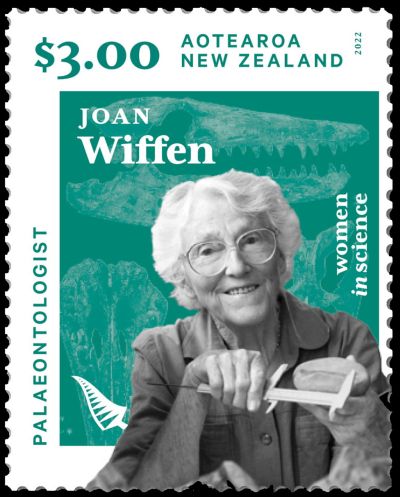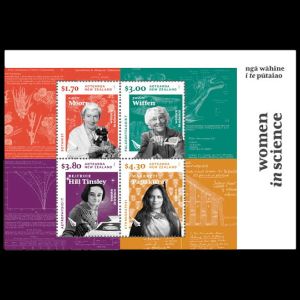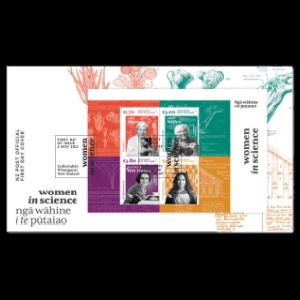New Zealand 2022 "Women in Science"
| <prev | back to index | next> |
| Issue Date | 02.11.2022 |
| ID | Michel: 3973-3976, Bl. 502d; Scott: 3051-3054, 3054a; Stanley Gibbons: 4317-4320, MS4321; Yvert et Tellier: 3724-3727, BF433; Category: pP |
| Designer | Jo Bailey, Wellington, New Zealand |
| Stamps in set | 4 |
| Value |
$1.70 - Lucy Moore (1906-1987) botanist and ecologist $3.00 - Joan Wiffen (1922-2009) palaeontologist $3.80 - Beatrice Hill Tinsley (1941-1981) astrophysicist $4.30 - Mākereti Papakura (1873-1930) (Tūhourangi), leader, guide, ethnographer |
| Emission/Type | commemorative |
| Issue place | Whanganui |
| Size (width x height) | stamps: 28mm x 35.16mm Mini-Sheet: 128mm x 90mm |
| Layout | Mini-Sheet with 4 stamps, Sheets of 20 |
| Products | FDC x2, M/s x1, SH x4, PP x1 |
| Paper | Arconvert securpost premium gummed 110gsm |
| Perforation | 13.50 x 13.75 |
| Print Technique | Lithography |
| Printed by | Southern Colour Print, New Zealand |
| Quantity | |
| Issuing Authority | NZ Post |

On November 2nd, 2022, the Post Authority of New Zealand issued the stamps set "Women in Science". The set contains four stamps, printed in individual Sheets of 20 and all together in a Mini-Sheet of 4.
According to the official press release, Mākereti Papakura, Lucy Moore, Joan Wiffen and Beatrice Hill Tinsley are four remarkable New Zealand women who achieved in the scientific fields of ethnography, botany, palaeontology and cosmology respectively, in the 20th century. Their contributions opened our eyes to our past, the natural world, our cultural traditions and legacies, and the universe.
| The red stamp ($1.70) depicts Lucy Moore (1906-1987) with images of Pterocladia lucida, one of the seaweeds she observed and described. In her long career she was responsible for the taxonomy of a variety of native flora. | The violet stamp ($3.80) depicts Beatrice Hill Tinsley (1941-1981). In her short but remarkable career Beatrice Hill Tinsley proved that the universe was infinite and would expand forever, and that galaxies evolved and interacted. This picture shows Hill Tinsley in her office at Yale University in 1975. | The yellow stamp ($4.30) depicts Mākereti Papakura (1873-1930) who was an anthropologist whose posthumously published work, The Old-Time Māori (1938), is now widely acknowledged as the first published scholarly work of ethnography written by a Māori scholar. |
The green stamp ($3.0) depicts Joan Wiffen (1922-2009) - a self-taught palaeontologist.
In 1974 Wiffen and her team discovered the first dinosaur fossils in New Zealand in the Mangahouanga Valley in Northern Hawkes Bay. She knew the bone was unusual, and of a land-dwelling creature, but it was several years before it was identified as belonging to a theropod dinosaur.
 |
 |
| The first New Zealand's dinosaur bone found by Joan Wiffen and her team. The fossil is in the collection of GNS Science. Image credit: mujeresconciencia.com | Hawkes Bay on definitive stamp of New Zealand 2016, MiNr.:, Scott: 3026 |
Some scientists questioned these conclusions.
In 1967, Charles Fleming, leading paleontologist of the Geological Survey
in Wellington, New Zealand, claimed there was good vegetation in New Zealand before the breakup
of Gondwana, sufficient to support herbivorous dinosaurs.
He suggested that the lack of dinosaur fossil record may simply be because
no fossils had yet been found.
" The first real excitement came unexpectedly in 1974, when Bill brought me a piece of rock and asked me to try my recently acquired skill of acid extraction.
Bill [William (Bill) Moisley] — a fellow enthusiast we had met on a local beach looking for fossils, and now a confirmed collector himself — decided to join us by sharing in the cost of the building Programme in exchange for a room of his own in the establishment.
In an attempt to reduce the size of the rock, he broke it in two, revealing a very large fish vertebra in addition to another fossil he thought was an ammonite. While preparing it, I saw a small hollow brown bone, broken in two, exposed on the rock surfaces. I carefully coated these fragments with the protective resin, and placed them in the prepared acid bath. Slowly, after repeated washing, cleaning and recoating, the fossils emerged. My interest was centred on the small hollow bone, because it was unusual, different from all the other material in the rock. ... We had a perfect toe bone. Judging by the shape of the two articular ends, this was certainly not a toe bone from a marine reptile, but from a land-walking animal. "Her guess was confirmed by Dr. Dave Russell, from the Museum of Natural History in Ottawa, Canada, who occasionally visited New Zealand in the same year. By looking at the fossil, he recognized it as a theropod toe bone.
In the next year, Joan Wiffen and her husband Pont discovered an unusual bone from the Mangahouanga Valley in Northern Hawkes Bay. It was small but clearly a backbone (vertebra). She puzzled over its identity for some years. Eventually she had it examined by vertebrate palaeontologist Dr. Ralph Molnar at Queensland Museum (Brisbane, Australia), who identified it as a tail bone of a carnivorous theropod dinosaur (Theropoda indet.).
In February 1980, Wiffen and Molnar announced their findings at the 'Fifth International Gondwana Symposium' held in Wellington. It was a remarkable publication that rewrote the textbooks of New Zealand's natural history. Before then, there was no descriptions of dinosaurs who lived in the country.
The Wiffen family and interested friends spent their weekends and holidays at Mangahouanga Stream, and later built a hut as a base there. At the Mangahouanga site, they have found fossil bones of at least three kinds of carnivorous dinosaur, three kinds of herbivorous dinosaur, and one kind of flying reptile. That is quite apart from some fine examples of marine reptile fossils and some rare and unique examples of other marine species.
These discoveries show dinosaurs lived in New Zealand after it split away from Gondwana in the Early Cretaceous.
As collecting continued, the Wiffens eventually extracted almost complete plesiosaur and mosasaur skulls, and marine reptiles remained Joan’s main focus for the rest of her career.
The skull of the Mosasaur Prognathodon overtoni is shown on the background of the stamp.
It is a reproduction of a plate from "New mosasaurs (Reptilia; Family Mosasauridae) from the Upper Cretaceous of North Island, New Zealand" an article written by Joan Wiffen in 1990.
In 1974 Wiffen found the skull of another mosasaur. In 1980 Wiffen published her first scientific paper describing a new mosasaur that she named Moanasaurus mangahouagae which is depicted on a stamp of New Zealand in 2010.
From the 1980s onwards she was increasingly recognised as the expert on New Zealand’s Cretaceous reptiles.
 |
 |
| Paleontologist Joan Wiffen stamp of New Zealand 2022, MiNr.: 3974, Scott: 3052. | Moanasaurus on stamp of New Zealand 2010 MiNr.: 2673, Scott: 2296. |
Joan Wiffen (née Pedersen) was born in 1922 and was brought up in Havelock North and the King Country.
Her father believe that higher education was wasted on girls, so Joan's educational opportunities were limited to a short secondary school education.
In 1953 she married Pont Wiffen, and they made a life together on a small farm in Hawke’s Bay, where they restored the derelict buildings, made a garden, raised two children and assorted farm animals, ran a couple of greenhouses and an asparagus patch, while Pont also worked in town. Joan’s interest in science was kindled through the natural history books she obtained to share with her young children.
In the late 1960s Pont and Joan developed an interest in collecting and polishing stones after Pont attended a geology night class. Pont and Joan Wiffen travelled widely in both New Zealand and Australia collecting both minerals and small fossils of sea animals with their children.
Both joined the local rock and mineral club, and in 1969 they visited Queensland with a group interested in Australian minerals and gemstones. Joan purchased a small trilobite fossil for 50 cents. She had been fascinated by fossilised shells on the Hawke’s Bay hillsides of her childhood, and she now realised that she was more interested in fossils than polished stones. Joan soon convinced Pont to focus on fossils instead of gemstones.
The couple were very interested in fossils, and Pont ended up taking classes on fossils. One day when Pont was home sick, Joan went to the class in his place and ever since then she was in awe of dinosaurs and fossils.
All the specimens Joan illustrated and described were deposited in National Paleontological Collections at the New Zealand Geological Survey, now GNS Science.
The marine invertebrates, mainly shells, were passed on to the New Zealand Geological Survey and other experts.
Joan Wiffen was a remarkable model for women in science – tenacious, courageous, and adaptable. Joan’s work on fossil reptiles was recognised by a special award from the Geological Society of New Zealand in 1986; by an honorary doctorate from Massey University in 1994; by the award of a Commander of the British Empire (CBE) in the 1995 New Year’s honours; and by the Morris Skinner award from the Society of Vertebrate Paleontology in 2004 for her contributions to scientific knowledge.
In 2017, Wiffen was selected as one of the Royal Society Te Apārangi's "150 women in 150 words", celebrating the contributions of women to knowledge in New Zealand.
Products and associated philatelic items
| Mini-Sheet | FDC | |
 |
 |
 |
| Presentation Pack | Sheets of 20 | |
 |
 |
|
References

|
 |
- Technical details: NZpost (the article does not exist anymore)
- Joan Wiffen: NZpost (the article does not exist anymore) Wikipedia, Museum of New Zealand, Teara, Strange Science, NZ Geo: [1] & [2], Cape Coast, Arts and Heritage Trust, Stuff, mujeresconciencia (in Spanish), Science Learning Hub.
- The Mosasaur: "J. Wiffen (1990) New mosasaurs (Reptilia; Family Mosasauridae) from the Upper Cretaceous of North Island, New Zealand, New Zealand Journal of Geology and Geophysics, 33:1, 67-85, DOI: 10.1080/00288306.1990.10427574"
- "Valley of the Dragons - the story of New Zealand's Dinosaur Woman", by Joan Wiffen, ISBN: 1-86941-145-5, printed in 1991 by "A Bookmakers Book" in Auckland.
- Charles Fleming:
TEARA (The Encyclopedia of New Zealand) [1], [2].
National Library Wellington.
Acknowledgements
Many thanks to
- Dr. Peter Voice from Department of Geological and Environmental Sciences, Western Michigan University, for reviewing the draft page and his very valuable comments.
- Marianna Terezow, Manager – National Paleontological Collection, GNS Science for reviewing the draft page, providing images, and her very valuable comments.
| <prev | back to index | next> |